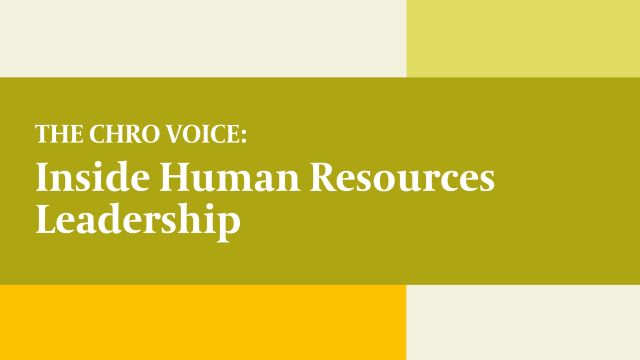The principle is simple: HR must remain firmly connected to the business strategy at all times. When that link remains connected, HR can continuously convert insights into tangible results.
 Vanessa DupuisCHRO of Celanese
Vanessa DupuisCHRO of Celanese
As companies today continue to navigate unprecedented economic and operational difficulties, how can HR leadership use its expanding role to empower people and enact positive change throughout the organization?
To shed light on this issue and better understand the future of HR as a driver of business strategy, we spoke with CHRO of Celanese, Vanessa Dupuis, who shared invaluable insights on the link between employee engagement and performance, including the importance of accountability, purpose, and wellbeing to help employees thrive and organizations overcome complex challenges.
Every role in the C-Suite seems to be broadening today, but particularly the CHRO role. How do you balance contributing more actively and meaningfully to business strategy while also performing your more “traditional” functional responsibilities?
At the core of my approach, I believe HR must always be tightly integrated with business strategy. While there are many initiatives within HR that are exciting and potentially rewarding, the primary goal must always be to deliver tangible value to the business, our customers, and shareholders.
To ensure this alignment, it is crucial that, as a function and as a CHRO, I remain deeply engaged with the broader business strategy and landscape. Regular dialogue with the C-suite and other senior leaders is key, as it helps us understand where the company is focused and what the most pressing challenges are. This allows us to adapt and refine HR programs, processes, and policies to ensure they directly address these business needs.
Furthermore, the relationship is reciprocal. By understanding the strategic challenges faced by the business, we are able to leverage HR’s expertise, particularly in analytics, to offer insights that can influence the company’s broader strategy.
For example, in our Manufacturing function, Celanese was implementing a new operating model across 56 global production sites. Over time, we noticed varying levels of engagement and adoption, with some sites lagging behind in their embrace of the new model. Through an engagement survey, we identified a significant correlation: sites that were more engaged with the new model achieved higher satisfaction on items related to role clarity, autonomy, decision making, and alignment on goals. By presenting these findings to leadership, we connected engagement directly with operational outcomes—arguing that not only would it drive higher quality and decision-making, but it would also improve team engagement. This data-driven insight was incorporated into our incentive plans, which helped accelerate momentum and propel the implementation forward after several years.
The principle is simple: HR must remain firmly connected to the business strategy at all times. When that link remains connected, HR can continuously convert insights into tangible results.
It sounds like you’ve been incredibly successful in becoming an equal player in shaping your organization’s future as a CHRO. Is there anything you would share with other HR leaders looking to do the same?
One of the key pieces of advice I always share with my team is that we must simultaneously be academically rigorous and business-relevant. In the world of business, we don’t speak the language of HR—we speak the language of the business.
This shift in mindset is essential for fostering strong partnerships with business leaders. When HR leaders speak the language of the business, it builds credibility and influence. Business leaders don’t view us as "HR," they view us as trusted partners and advisors. A recent example of this occurred when a business leader, returning after a four-year absence, immediately emphasized the need to have both his finance and HR partner sit with him to drive the business forward. This placement of an HR leader beside the business leader speaks to the respect and understanding that HR is no longer just a support function but a strategic partner critical to the company’s success.
What are your main priorities today when it comes to talent management?
From a talent perspective, we’re currently focused on a few critical areas. Given the macroeconomic headwinds facing our industry, the employee experience has never been more important. One of our core differentiators has always been our culture—we’re a company that genuinely believes in the power of people. In fact, people is listed first in our company’s core values, and that’s not just symbolic. It’s foundational.
We recently launched a new campaign aimed at elevating the employee experience in meaningful, tangible ways. A central part of that effort is aligning our talent management priorities with clarity and accountability. We’re asking: How do we help every employee feel connected to the company’s mission, and how do we make sure they understand how their contributions drive value?
We’re asking: How do we help every employee feel connected to the company’s mission, and how do we make sure they understand how their contributions drive value?
Vanessa DepuisCHRO of Celanese
That means sharpening our focus on goal setting, making sure we’re clearly articulating expectations, and creating accountability frameworks that are rooted in real business outcomes. If we don’t set the stage with clear goals, we won’t be able to drive alignment—or success—throughout the year.
Equally important is how we recognize and support our people along the way. We’re investing in more effective manager-employee check-ins and expanding both pay-based and peer-to-peer recognition programs. We’ve seen that employees who feel truly valued are four times more engaged, and that engagement directly fuels discretionary effort—which is absolutely critical in times like these, when delivering results requires everyone to go the extra mile.
Ultimately, our goal is to foster a culture where employees feel seen, empowered, and aligned with the company’s purpose. When you get that right, it becomes a powerful multiplier for performance and resilience.
For many companies, it can often seem like there’s tension between the ideas of creating a positive employee experience and achieving business results. But you seem to be flipping the script in that area, supporting people first as a strategy to reach the outcome. Can you tell us more about that approach?
It all begins with keeping employees connected to the company’s broader mission and goals, never losing sight of the ultimate aim: delivering value to customers and shareholders. For example, when we’re thinking about leadership development, we ensure that the employee experience is part of a larger learning, growth, and development journey. We want our people to know that we are invested in their personal growth just as much as we are in the company’s success.
Moreover, we understand the importance of managers creating an environment where employees feel a sense of well-being and belonging. In times of disruption, like the ones we’re currently facing, this is even more critical. I’ve had numerous conversations with employees across the globe, stressing the importance of self-care and mental well-being. To support this, we’re launching new training programs for people leaders, equipping them with practical tools to foster this sense of belonging. Creating these empowering moments for teams is not just about feeling good—it directly contributes to performance and retention.
It all begins with keeping employees connected to the company’s broader mission and goals, never losing sight of the ultimate aim: delivering value to customers and shareholders.
Vanessa DepuisCHRO of Celanese
At the end of the day, leaders want to win the hearts and minds of their teams. But they often struggle with how to activate that. Our role is to provide them with the tools, frameworks, and ongoing support to help them create that environment and then hold them accountable for doing so.
You’ve truly had such an exciting and interesting career. Do you have any advice for upcoming HR leaders?
My career path to CHRO has been somewhat unconventional. I came up through talent management, which gave me a people-first lens I carry into every aspect of my current role. That background has been a real asset, but it’s also shown me the areas where I’ve had to grow—and data analytics is one of them.
I recently spent an entire weekend diving into the relationship between employee engagement and sales performance, and I couldn’t help but think how much more efficient—and impactful—I could have been if I had a stronger foundation in data analysis. That experience was a reminder: as HR leaders, we have to be just as fluent in numbers as we are in empathy.
Looking ahead, I believe one of the biggest game-changers for our field is the rise of artificial intelligence and automation. As a function, HR needs to move faster in embracing these technologies. They’re not just operational tools, they’re strategic accelerators. In the future, I see proficiency in AI, automation, and data analytics as essential differentiators for successful CHROs. The ones who lean in and master these capabilities will be the ones shaping the future of work—and driving real, measurable business outcomes.











